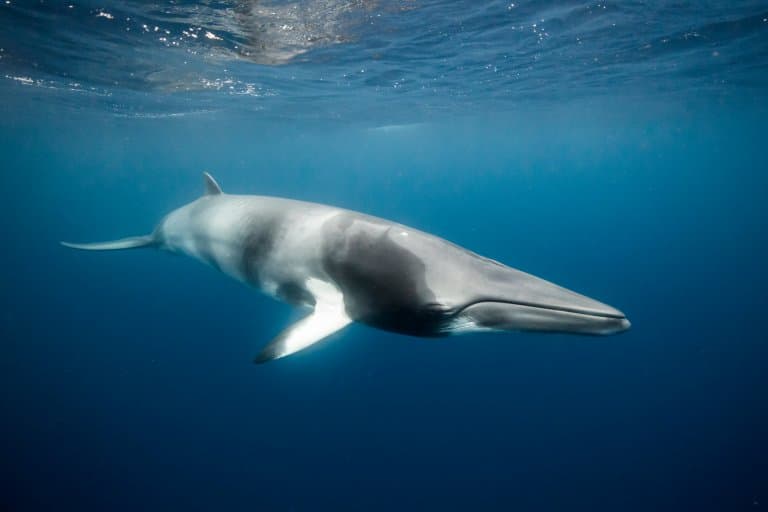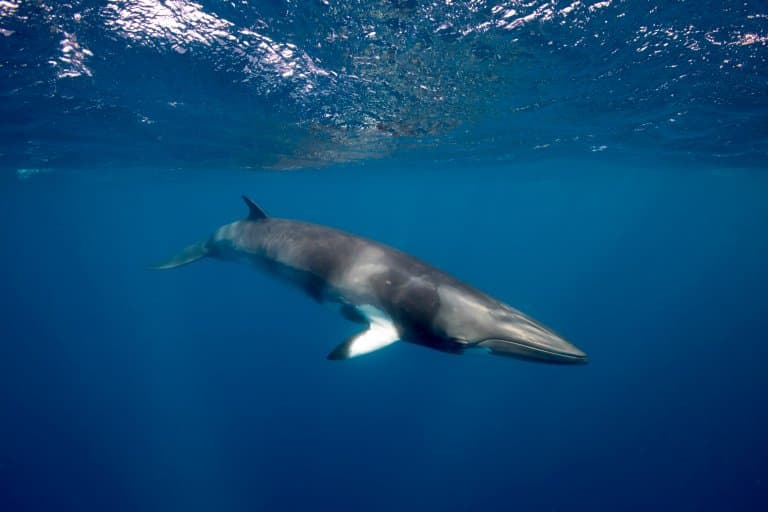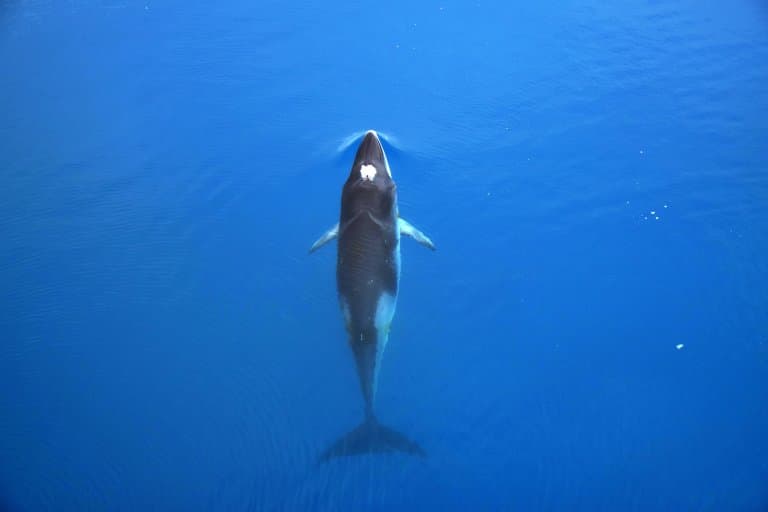Minke Whale Profile
There’s a species of whale (or two, or three, depending on whom you ask) that evaded capture through the entire golden age of whaling. Their small size inspired mockery and merciful neglect from whaling vessels, keeping them relatively safe.
They were, for so long, the antipode of the Right whale, but this has recently changed. Now they’re in danger, and they need our help!
The minke whale also known as the lesser rorqual, are actually two species of baleen whale. The common, or northern minke whale, and the Antarctic or southern minke whale.

Minke Whale Facts Overview
| Habitat: | Global oceans |
| Location: | Worldwide, primarily Pacific, Antarctic and Atlantic |
| Lifespan: | Up to 60 years |
| Size: | Up to around 9 m (30 ft) long |
| Weight: | 10 to 12 tons |
| Color: | Black, gray, and purple |
| Diet: | Krill, schooling fish |
| Predators: | Killer whales |
| Top Speed: | 30 kph (18 mph) |
| No. of Species: |
2 (but, maybe 3) |
| Conservation Status: |
Least concern (Common minke whale), Near threatened (Antarctic minke whale) |
Minke whales may be the last of the ocean’s megafauna to remain relatively intact after a brutal rampage that wiped out around 2/3 of the world’s mammal biomass in one century.
This was largely due to their size, as the second smallest balleen whale after the pygmy right whale. They measure on average around 8 m (27 ft) in length, and 7 tons in weight. They have a distinct black, gray, purple color with a white underside.
Minke whales have between 240 and 360 baleen plates on each side of their mouths and can dive for up to 20 mins to feed predominantly on krill, capelin, sand eels, herring and anchovies.
While their populations are one of the healthiest of whales, their status is threatened by a couple of archaic industries that have failed to move on, and they’re now hunted by the thousands.
These are curious, gentle, and emotionally intelligent animals that should be held in much higher regard, even if they do have herpes (yes, really – read on!).
Interesting Minke Whale Facts
1. They’re named after a mistake
Minke whales are the smaller cousin of blue whales. The genus also contains the Bryde’s whale, fin whale and the Sei whale. All of these are so hard to tell apart you’d have to be a whale nerd to notice the difference (and you’d have to get a look at the ridges on their heads or the band on the Minke’s flipper).
But the Minke is much smaller. They’re roughly a third of the length of their record-breaking relatives, which is the most reliable way to know what you’re dealing with.
As a result, Minke whales were never really on the menu, and there are two contrasting stories around the origin of the name:
The first is of an overzealous Norwegian lookout on a whaling ship, raising the alert at every fin he saw, leading to these smaller, waste-of-time whales being mockingly named after him.
The second tells of a German known as Meincke, who mistook a school of Minke whales for Blues, and was tarred with the same derision as in the previous story.
Either way, it seems like the whale was so uninteresting to whalers that it was only named as a bit of a laugh, and that whalers can be a merciless and unforgiving bunch if you’re foolish enough to slip up.
In contrast, the Right whale was named because that was the one they were truly looking for. Presumably, the Minke was a slight twist of fate away from being called the Wrong whale.

2. They are the most abundant Baleen whales
But not for good reasons.
This small stature made the Minke less economical to the old whalers than the larger, more blubbery options, and this is what has allowed them to maintain healthy populations in the wake of the most extreme human-caused megafauna devastation in history.
More than 2 million of the biggest animals that have ever existed on the planet were slaughtered in just one century.
To put that into perspective, if you gathered up all the mammals on earth today, you’d have less than half the mass of what was killed by whalers in 100 years.
What remained was the dinky Minke; the butt of jokes. Smaller, seemingly useless whales that wouldn’t bring in nearly enough oil to be worth chasing.
As such, most minke populations are relatively healthy, but not for long. 1
3. They’re the new target
Whaling as an industry has certainly died down since the golden age of exploding harpoons and genocidal cravings for whale oil, but it isn’t dead yet.
Japanese fleets make use of ‘research’ permits – presumably issued to research just how many whales they can get away with eating – to continue commercial whaling in the Southern Ocean.
Over 900 whale kills were permitted as part of a loophole in an otherwise universal ban on whaling (one which Norway just ignores).
Since receiving pressure from the UN against this, Japan has dropped all pretence and withdrew from the International Whaling Commission altogether, and consequently from the bind of their anti-whaling laws.
In the Northern populations, traditional Norwegian whaling fleets have given way to modern industrial practices, with roughly 5,000 Minke whales slaughtered in the past decade. Many of these are being sold to Japan, whose Southern stocks are now dropping and have become listed as “Near Threatened” by the IUCN. 2

4. They’re hard to count
The species complex of minke whales makes things difficult to measure. Currently, it’s thought that there are two distinct species, and a subspecies of even smaller, dwarf Minke.
However, the differences are so slim that even the Japanese haven’t figured it out for certain from their thousands of research samples.
This, along with other factors, makes population trends hard to measure, and it’s possible that there is untold damage going on from all the whaling operations as a result.
Both Norwegian and Japanese whaling industries try to push the agenda that they are hunting sustainably, but with a distinct lack of information, and the obvious commercial bias involved in these claims, they can be taken with a grain of salt.
And this is a true tragedy. Because the Minke is one of the last healthy populations of baleen whales we’ve got. 3

5. They use fat to hear
These boings are picked up using special ear fats that are seemingly very similar to the mechanisms used by toothed whales like the orca.
While baleen whales are not thought to use echolocation (at least as much as their toothy relatives), the organ for hearing does suggest a similar application and offers an insight into a theory of cetacean sound reception that’s still sorely lacking. 4
6. They are curious
Minke are notoriously curious animals, and much like dolphins, are often seen chasing the bow of boats. They also approach divers readily with a naïve innocence.
While other whales are likely well aware of the dangers of human presence, minke whales seem so far unaware of our reputation. They also breach, seemingly for fun and to see what’s happening around them! 5
7. They can catch herpes
It’s unlikely that whale herpes stemmed from minke getting a little too close to divers, but it’s fun to think about.
This is an example of one of the many STIs that get spread around in the animal kingdom, confirmed in baleen whales by molecular analysis in 2015. 6
8. They migrate up to 400 km
Both species of minke whale migrate in the spring to the poles, and towards more temperate waters during winter.
While much about their migration is not known, they can travel over 400 km in search of warmer waters.
9. They are loved by killer whales
But not in a good way. A study performed in 1975 of 49 killer whales stomach contents, showed that 84% of them had eaten minke whales.
Minke whales reaction to encountering a killer whale is to swim away as fast as possible. Minke whale have pointy heads and short dorsal fins which enable it to swim at high speed.
Killer whales will chase minke whales, which have been witnessed hiding under the hull of boats to aid their escape. However, killer whales are also extremely fast and often work in teams – often the minke whales endurance is what will keep them alive.
10. They’re non-human persons
There’s lots of talk about the environmental and ecological impact of whaling and population declines, and so on, but what’s often overlooked is the brutality against individuals and families.
It would be cold and borderline obscene to look at the holocaust through the lens of population declines in various marginalised groups. The most tragic part of any conflict is the individual, personal loss and suffering. Yet, the personhood of marine mammals is routinely ignored.
Whales have incredible intelligence; some matching our own in many ways. They have vocal language, they have communities, they identify themselves by name and have family names too. Whales communicate with a range of vocalisations. Minke whales typically use what’s known as a ‘boing’
These, by all accounts, are non-human persons with lives and thoughts and wants. And we as a species are routinely exploding their heads in front of their children and drowning them in nets.
Whalers kill pregnant females, juveniles, matriarchs and fathers, and they do so in the presence of their families – something which necessarily has an impact on a culture we know so little about. 7
Minke Whale Fact-File Summary
Scientific Classification
| Kingdom: | Animalia |
| Phylum: | Chordata |
| Class: | Mammalia |
| Order: | Artiodactyla |
| Family: | Balaenopteridae |
| Genus: | Balaenoptera |
| Species Names: |
Balaenoptera Acutorostrata (Common minke whale or northern minke whale) Balaenoptera Conaerensis (Antarctic minke whale or southern minke whale) |
Fact Sources & References
- Savoca, M.S., Czapanskiy, M.F., Kahane-Rapport, S.R. et al. (2021), “Baleen whale prey consumption based on high-resolution foraging measurements“, Nature.
- Justin McCurry (2013), “Australia censures Japan for ‘scientific’ whaling“, The Guardian.
- “Whaling in Norway“, Whale and Dolphin Conservation.
- Maya Yamato (2012), “The Auditory Anatomy of the Minke Whale (Balaenoptera acutorostrata): A Potential Fatty Sound Reception Pathway in a Baleen Whale“, PMC PubMed Central.
- Perrin, W. F., Mallette, S. D., & Brownell, R. L. (2018), “Minke Whales“, Encyclopedia of Marine Mammals.
- Melero, M., Crespo-Picazo, J.L., Rubio-Guerri, C. et al (2015), “First molecular determination of herpesvirus from two mysticete species stranded in the Mediterranean Sea“, BMC Vet Res.
- Ylenfest (2018), “Orcas, Dolphins, and Whales: non-human persons and animal rights“, Bill of Health.
